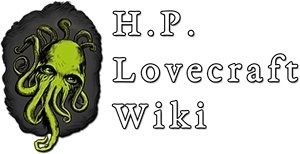![]()
![]() Robert William Chambers was an American artist and writer.
Robert William Chambers was an American artist and writer.
Biography[]
He was born in Brooklyn, New York, to William P. Chambers (1827 - 1911), a famous lawyer, and Caroline Chambers (née Boughton), a direct descendant of Roger Williams, the founder of Providence, Rhode Island. Robert's brother was Walter Boughton Chambers, the world famous architect.
Robert was first educated at the Brooklyn Polytechnic Institute,and then entered the Art Students' League at around the age of twenty, where the artist Charles Dana Gibson was his fellow student. Chambers studied at the École des Beaux-Arts, and at Académie Julian, in Paris from 1886 to 1893, and his work was displayed at the Salon as early as 1889. On his return to New York, he succeeded in selling his illustrations to Life, Truth, and Vogue magazines. Then, for reasons unclear, he devoted his time to writing, producing his first novel, In the Quarter (written in 1887 in Munich ) . His most famous, and perhaps most meritorious, effort is The King in Yellow, a collection of weird fiction short stories, connected by the theme of a book (to which the title refers) which drives those who read it insane. Chambers' fictitious drama The King in Yellow features in Karl Edward Wagner's story "The River of Night's Dreaming", while James Blish's story "More Light" purports to include much of the actual text of the play.
Chambers' returned to the weird genre in his later short story collections The Maker of Moons and The Tree of Heaven, but neither earned him such success as "The King in Yellow" .
Chambers later turned to writing romantic fiction to earn a living. According to some estimates, Chambers was one of the most successful literary careers of his period, his later novels selling well and a handful achieving best-seller status. Many of his works were also serialized in magazines.
Chambers, for several years made Broadalbin his summer home. Some of his novels touch upon colonial life in Broadalbin and Johnstown.
On July 12, 1898, he married Elsa Vaughn Moller (1882-1939). They had a son, Robert Edward Stuart Chambers (later calling himself Robert Husted Chambers) who also gained some fame as an author.
| “ | Chambers is like Rupert Hughes and a few other fallen Titans - equipped with the right brains and education but wholly out of the habit of using them. | „ | |
| ~ HPL , Selected Letters 2.282 |
| “ | So much of Chambers's work exasperates, because we feel that he might so easily have made it better. | „ | |
| ~ Frederic Taber Cooper |
He died at his home in the village of Broadalbin, New York on December 16th 1933.
A critical essay on Chambers' work appears in S. T. Joshi's book The Evolution of the Weird Tale (2004).
In the Mythos[]
Chambers wrote the King in Yellow, influenced by the Necronomicon. (HPL: History of the Necronomicon)
He changed reality by the powers invoked by his writings, making his suicide chambers a real thing known as "exit gardens". (EXP: Providence)
Works[]
- In the Quarter (1894)
- The King in Yellow (1895)
- The Maker of Moons (1896)
- The Mystery of Choice (1896)
- Lorraine (1897)
- Ashes of Empire (1898)
- Cardigan (1901)
- In Search of the Unknown (1904)
- The Reckoning (1905)
- The Tracer of Lost Persons (1906)
- The Tree of Heaven (1907)
- The Green Mouse (1907)
- The Common Law (1911)
- The Gay Rebellion (1913)
- Quick Action (1914)
- Athalie (1915)
- Who goes There! (1915)
- Police!!! (1915)
- The Slayer of Souls (1920)
- The Talkers (1923)
- The Yellow Sign and Other Stories: The Complete Weird Tales of Robert W. Chambers (2001, ed. S. T. Joshi)- collection of his horror and fantasy tales
